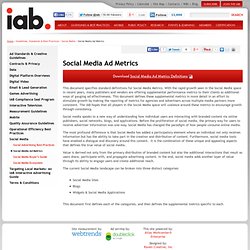

Building the social enterprise. Why do so few companies capture the full value of social technologies?

There’s no doubt organizations have begun to realize significant value from largely external uses of social. Yet internal applications have barely begun to tap their full potential, even though about two-thirds of social’s estimated economic value stems from improved collaboration and communication within enterprises. Although more than 80 percent of executives say their companies deploy social technologies, few have figured out how to use them in ways that could have a large-scale, replicable, and measurable impact at an enterprise level. Just over a quarter of executives say that their companies have significantly incorporated social technologies into the day-to-day work flow by, for example, adapting internal structures, systems, processes, and practices to the greater connectedness they enable. Companies are missing a potentially huge prize. So what should be done? Add value, not complexity Experiment and learn.
How Advertisers Can Maximize Mobile Conversions - Mahi de Silva. By Mahi de Silva | 8:00 AM June 12, 2013 In the beginning, mobile advertising was all about conversions.

Remember QR codes? Won’t You Be in My Nextdoor Network? - Katherine Boehret - The Digital Solution. If you’re like a lot of people, you use Facebook to keep in touch with friends who live hundreds of miles away.

The neighbors you can wave to from your front yard? Not so much. Though it sounds counterintuitive, you might get to know your next-door neighbors better by joining a free social network called Nextdoor from a company of the same name. This hyper-local site verifies users by address, uses each person’s real name and doesn’t allow people access to a network if they don’t actually live in the neighborhood. The 7 Habits of Content Brands that Dominate - Search Engine Journal. Can you hear that sound?

It’s the sound of a million fingertips clicking against keyboards, pumping out the tsunami of content that’s about to bury the public. The modern consumer is immune to infomercials and jingles, and all the search and social ads are starting to wear thin. Content is an island in the ocean of marketing messages consumers are drowning in, and the waters are rising. In the years ahead, consumers are going to tighten their filters even more.
Attention grabbing titles and sleek web design are going to disguise spam in Pinterest clothing. The secret to making that happen isn’t just to “go viral.” Habit #1. The internet gives us access to an incredible amount of information, but it can also lead us straight into a trap of our own design. People don’t use Facebook because of all the ads and brands they can “like.” People don’t read the New York Times, Mashable, or Gizmodo because they have great SEO and marketing departments. Marketing is not mind control. Habit #2. Social Media Ecosystem. Social Media Buyer’s Guide. Social Media is an increasingly important marketing tool.

Measuring the full impact of digital capital. On July 31, 2013, the US Bureau of Economic Analysis released, for the first time, GDP figures categorizing research and development as fixed investment.

It joined software in a new category called intellectual-property products. In our knowledge-based economy, this is a sensible move that brings GDP accounting closer to economic reality. And while that may seem like an arcane shift relevant only to a small number of economists, the need for the change reflects a broader mismatch between our digital economy and the way we account for it. This problem has serious top-management implications. To understand the mismatch, you need to understand what we call digital capital—the resources behind the processes key to developing new products and services for the digital economy. Conventional accounting treats these capabilities not as company investments but as expenses, which means that their funding isn’t reflected as capital. The big picture This activity is starting to power growth. Social Media Ad Metrics.
This document specifies standard definitions for Social Media Metrics.

With the rapid growth seen in the Social Media space in recent years, many publishers and vendors are offering supplemental performance metrics to their clients as additional ways of gauging ad effectiveness. This document defines these supplemental metrics in more detail in an effort to stimulate growth by making the reporting of metrics for agencies and advertisers across multiple media partners more consistent. Social Advertising Best Practices. Social media is big and getting bigger, providing marketers with a combination of reach, relationships, and relevance: Reach: Social media has overtaken email as the most popular consumer activity, according to a recent Nielsen study.
Importantly, consumer growth is coming from an older demographic than social media's historical base; for example, Facebook's strongest growth is coming from 35-49 year-olds, adding twice as many 50-64-year-olds as opposed to those under 18. (Nielsen “Global Faces and Networked Places,” March 9, 2009; MediaPost Blogs Research Brief, “Social Networking Is No Respecter of Age,” March 18, 2009.) Oscar Trimboli.